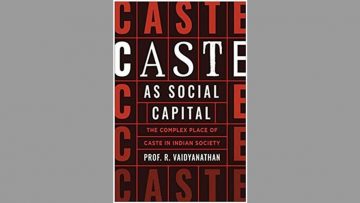Systems change as the governing principle of developmental change evolved in the western world within their political cultural framework of codified democracy, jurisprudence, and thought. Despite cracks in applications of this framework worldwide, the limitations have not been recognized as arising from a restricted lens. The asymmetries in expectations, outcomes, scale and sustainability of development change in different parts of India that investors and funders lament about is a result of castigating rather than integrating the crucial lens of culture and traditions (C&T) to view and effect system change. Culture, as a composite of relationships, norms, long established in “circles of trust” that include immediate and extended family members, gurus, social and religious group members, and the relationships and responsibilities that have evolved to sustain them, even over generations, are the foundation of sustainability and hence of system change.
Part I of this series outlines the limitations of systems theory and practice viewed outside of the C&T lens.
Part I – Limitations of Systems Theory and Practice
I. The Original Lens for Systems Change
There is much focus in management these days on systems. System-driven, systemic change, system-breakdown, systemic shifts, even system-disruption (hailed as innovation) are jargon that we are bombarded with. In the field of development management or that area of management that is concerned with improving the conditions of disadvantaged areas in India and lives of communities living in such areas, the search for “systemic impact” has become a mantra. And this has been influenced by the world of social venture capital (now renamed impact investing or impact philanthropy). This world began in Silicon Valley and through millionaires mostly made in the USA.
The origins of systems focus in the social sciences can be found in the cultures and traditions (C&T) that gave rise to it. C&T are at the root of all consciousness. We understand, interpret and think in ways deeply embedded in C&T and so our biases and prejudices are bound to it. C&T are dynamic so we evolve to imbibe new influences that modify how consciousness is played out and how our personal and collective identities are defined.
The various disciplines of the social sciences (economics, politics and sociology) developed within the framework of thinking and practice of the western world in the 19th and 20th century. Systems focus was derived from this and emanated from the work of social scientists, the most famous of them being Max Weber. The key concepts that underlay the systems theorists were stability and order encased in their norms and beliefs of the desirable direction in which institutions and human behavior should be guided worldwide. The natural sciences that looked for regularity in abstractions from the non-human world provided the cue for social sciences in the quest for a value-neutral social science.[i] This was followed by cybernetics and even game theory as useful antecedents for the articulation of systems theory that also had forecasting power. In political science, the most famous systems theorist was David Easton.[ii] His inputs, outputs, feedback loop model was attractive for its simplicity while being able to look at the “whole” system as continuously working and oiled by demands and support (inputs) in the internal and external environment (society, state and politics). The system would regulate these before moving them forward as decisions and actions (outputs), which then flowed back as further inputs. Easton’s model was considered the equilibrium or stability model that moved everything smoothly through the loop as interdependent elements.
The system and its interconnectedness was attractive to many disciplines of the social sciences including psychology and, later, social work and behavioral science as well because it enabled analysis of constituent units called subsystems (such as family, associations, clans) that made up the system and how they could evolve to maintain equilibrium in the whole system.
The equilibrium model was, however, not politically benign. The state was viewed as key to the maintenance of stability, particularly the democratic state; democracy having been decided by system theorists as providing the best option for equilibrium as defined and demonstrated in the west. Along with funding from the US government to influence the political direction of the newly independent states of Asia and Africa post-Second World War, the social sciences and its derivative, systems theory, was firmly embedded in the export of thought from the United States. Despite unease even among some American social scientists about systems theory’s political and socio-cultural roots in western thought that defied its claim for value neutrality because of its concern for “order, for maintaining the status quo, which is now seen to be favorable and essentially just,”[iii] systems theory remained strong across the various social sciences. This was attributed to the preoccupation with predictability in order to change state and society for the better.[iv] This “better” was value-laden and assumed by its proponents to be understood by the consumers of systems theory.
This fixation with stability and predictability continued into the field of finance, social development, philanthropy and social investments as they progressed in the later part of the 20th century and into the 21st century, this time in the United States of market and corporations. These various frameworks were exported through funding in post-colonial nations now called emerging markets; globalized and aspirational like the market-driven nations of the western world. The equilibrium-enhancing market model was already established as desirable and viewed as natural for export. But it became a dire necessity and need of a greater thrust when the model was in fact challenged in post-colonial nations. This challenge had its basis in the opposites; in diversity (cultural, political, social and economic) and not in sameness; in changeableness rather than regularity. More critically, market equilibrium was confronted by progressive inequality, even at its source, i.e., the USA.
Development studies that dealt with issues of poverty, inequality and social exclusion in now emerging markets critiqued the market focus but remained unequal to the task of drawing the insight and action required to manage the rising aspirations for market inclusion with tempering the greed that generally accompanies it. Over-extraction of natural resources following certain forms of development progress, loss of livelihoods due to disasters following climate change became overwhelming and needed new thinking and action plans. Philanthropic foundations that followed to alleviate the inequality and disparity by largely funding civil society organizations for several decades were dissatisfied with what they viewed as limited impact of their grantmaking. The funds fixed the needs of the beneficiaries in, for example, educational attainment, housing for the homeless, and elderly care but did not address critical issues in influencing policy and governance.[v] The limited impact that they saw led them to question their methodologies to address and remedy the root causes rather than only the immediate needs. Environment and social challenges were also affecting sustainability not just of the interventions but also of overall global development.
System change remained their answer but now emphasizing the strategic over the direct and immediate and cross-sector collaborations to mobilize stakeholders to create shared solutions. “Building alliances that create the conditions for a solution to emerge and take hold is a very different pursuit from the usual grantmaking process of trying to direct funds to the one organization that offers the most appealing approach. “Systemic reform”, says Mark Kramer, “requires a relentless and unending campaign that galvanizes the attention of the many stakeholders involved and unifies their efforts around the pursuit of a common goal.”[vi] Note that the author says system “reform” (which has a normative connotation) and not just system “change.”
A variety of ways have since emerged in philanthropy and now, market-oriented investment space, for the insight and action points to catalyze system change. They have moved from funding projects to funding social entrepreneurs and commercially-oriented social enterprises as a means for scalable and strategic solutions that can be taken forward through policy and collaboration with institutions, including NGOs, corporates and research institutions. Nevertheless, they remain trapped in the focus on high returns defined as geographical and numerical scale, earnings and system change (including policy). Micro-finance became big-business because of high returns on all these parameters and was considered the flag bearer for social investments even in other development spheres, except that these other areas could not yield the returns that microfinance managed. Despite the experiment with nomenclatures for funding systemic social change post microfinance (impact investing preferred over just investing, impact philanthropy rather than just philanthropy) “impact investments rarely stray from the conventional investment approach that prioritizes capital preservation and profits.”[vii]
While system change proponents called for new narratives for capital and markets to act responsibly, the transactional nature of remedies persisted. Partnerships and collaborations mentioned above and big data to drive actions on the ground are some examples. Examples in financing are shared risk funds (pooled and deployed using customized terms of return for different initiatives), regenerative economy funds (for climate change and economic justice). Since external finance and markets that push the system change lens are themselves transactional, fleeting, and unequally distributed nationally and globally, not to mention derived from codified, externally networked and enforced variable rights, law, governance, and policy, the jury is still out on what all these instrumental contortions really mean for the good life for the common citizen in emerging markets.
II. Culture and Traditions Lens for System Change
Clearly, we need a different lens for understanding system turbulence and managing it; based firmly in the assumptions, influences and management of the context that governs the interconnectedness of actors and institutions in the particular system or subsystem being studied and supported. In and of itself, system as a concept is not problematic as it recognized that it is not a disjointed set of individuals and institutions but those that connect, interact and share in some way on a continuous basis all the while impacting shifts and getting impacted. However, the democratic nation state governance arrangement that underlies the narrative and instruments of system change and that evolved historically, as shown in this paper, emerged from C&T not homegrown in post-colonial nations/emerging markets. It is not surprising then that identities, interests, and imperatives in India as a post-colonial nation mediate the formulations for and implementation of the inherited governance construct that result in repeated adjustment of official priorities, policy, and pace (3Ps).
Indeed, this happens even in developed and market economies but the diversity of C&T in India work in ways that is often considered by commentators and visitors to India as “chaotic” and, by implication, not the measure of stability that would be considered desirable by their standards. Laws (their creation, implementation, adjudication) which are viewed in western democracies as the quintessence of stability generation, are actually products of C&T and shifting power equations though there is also a view (from American jurisprudence) of a “legal culture” with its own description. “The law that the courts create and apply is a distinct cultural system. Law practitioners internalize this culture in the course of their studies and professional activity, and this internalization comes to constitute, direct, and delimit the way these practitioners think, argue, resolve cases, and provide justifications.[i] However, laws everywhere are made, interpreted and implemented by people within the C&T context in which they operate. American jurisprudence would be no exception. Indian C&T are very diverse and affect, even more greatly, the enactment of laws, their interpretation, implementation and their adjudication from the national to the local. An interesting view of role of law, put forward by Kaushik Basu and derived from game theory, is that it changes expectations of behavior rather than creates new behavior. “The all-encompassing game that people in a society play is given. A law does not change that. What it does is, within that game of life, create beliefs and expectations in our heads about other people’s behavior. It is these changed expectations that lead to changed behavior. Beliefs and norms can be equilibrium-generating.”[ii]
Where culture is seen to be positive it is objectified, i.e., to be preserved and protected as heritage and spread as “cultural industries”. UNESCO is an institution almost entirely devoted to preservation of heritage around the world. C&T here is not the prism for understanding, interpretation and action (which is the concern of this paper) but a domain of expertise.
The Indian state and institutions have a dynamic relationship of support and collision with its inherently diverse C&T. As Indians we are, all at once, trying to deal with this layering in our aspirations and relationships (family, community, professional, citizen). However, as in many emerging economies, the national imperatives are short term, mostly dependent on the five-year term of the party in power. So, the relationships with the state are subject to even more turbulence, as the 3Ps are highly variable. As aspirations increase and the state’s resources are stretched in trying to meet them, trust in the capacity and intent of the state to deliver takes the blow. The formal arms of the state legislature, executive and judiciary are themselves subject to push and pull of embedded C&T that are colliding with and moving between entitlements and responsibilities. And with India’s federal structure of states and administrative units down to the village with varying C&T -mediating dictats and decisions given, received and responded to, western constructs of stability are misplaced in India.
A key element for equilibrium is trust. Equilibrium is maintained by people’s agency (cognitive and action) within the C&T context that they trust because that context is familiar, understood, can be navigated and depended upon, and has its internal reasoning. And because of all these factors, conflict and change is decentralized and manageable. Networks built around C&T-based agency become more prominent for provisioning of needs than the fluid and vacillating governance and laws. I will call these networks “circles of trust” and to this I now turn.
C&T reside in a composite of relationships, beliefs, established in “circles of trust” that include immediate and extended family members, gurus, social and religious group members, and the relationships and responsibilities that have evolved to sustain them and their social contracts over generations. The relationships within are a combination of many emotions and behavior (combative and conciliatory; supportive and oppositional; argumentative and pliable) but these are trusted because they are familiar and part of our lived experience. While the C&T of developed market economies that have framed the system stability and change perspectives as well as instruments that India has imported are considered desirable (even if they are inadequate or unsuitable), Indian C&T are considered regressive because they are not framed in a way recognizable by constructs created under different C&T even though they are dynamic and contribute to adaptation and sustainability.
The time has come to pushback on the exclusivist view that C&T cannot be the lens through which to effect system change in India, especially, if we can acknowledge through our own consciousness that C&T are the basis of how we process knowledge and action. Indian C&T recognizes the “cosmic” as the system of which the tangible citizen relationships with family, community, and country are parts and locus of actions and in which duties, responsibilities, ethics, reasonableness and similar beliefs are woven in diverse and changeable patterns. Unfamiliar experience and influences are filtered through this cultural prism in our thinking and action and responses are usually incremental. The Indian civilization, Michel Danino says, is a “rich cosmic tapestry which connects the whole web of life together and imparts meaning as well as a purpose to all its elements.”[iii] The support and collision spoken about earlier in this paper are accepted as a part of this awareness of the whole but acted upon through our everyday relationships.
Indeed, the familiar circles of trust for individuals that have been built up over time are the only reliable nurturing source towards change. Circles of trust respond to internal navigation using familiar forms of negotiation as well as new ways learnt by individuals through interactions within and outside the circle. As markets, governance and legal systems as well as the institutions and relationships that work in them become more opaque and less reliable in their impact on citizens (indeed, even unsafe, as the data shows, especially for girls), the system that can be navigated and changed most enduringly is one the individuals are most familiar with and in contact with on a daily basis. The asymmetries in expectations, outcomes, scale and sustainability of development change in different parts of India that investors and funders lament about is a result of this lack of understanding of how individuals work through their first hand cultural connects and lived experience that can provide the new non-linear principles of management for system change.
References
[1] Chilcote, Ronald, Theories of Comparative Politics, The Search for a Paradigm, Westview Press, 1981, p. 30.on
[1] Easton, David, A Systems Analysis of Political Life, New York: Wiley, 1965.
[1] Chomsky, Naom, The Menace of Liberal Scholarship, The New York Review of Books, January 2, 1969
[1] Chilcote, p. 141.
[1] Walkerly, Kris Putnam, The Role of Philanthropy in Systems Change, Putnam Consulting Group, 2017
[1] Kramer, Mark, Catalytic Philanthropy, Stanford Social Innovation Review, Fall 2009.
[1] Fram, Stu, The Next Step in Impact Investing: Breaking the Shackles of Extractive Thinking, Stanford Social Innovation Review, July 23, 2018).
[1] Mautner, Menachem, Three approaches to law and culture, Cornell School of Law, 2011.
[1] Basu, Kaushik, The Republic of Beliefs: A New Approach to ‘Law and Economics’, Policy Research Working Paper 7259, The World Bank, 2015
[1] Danino, Michel, The Universal in Indian Culture, The New Indian Express, July 11, 2018
(Note: Indic Academy supported the author to attend the Conference on Indian Culture vs. Western Culture at IIM Kozhikode. This series is part of the work presented by the author at the Conference.)
Disclaimer: The opinions expressed in this article belong to the author. Indic Today is neither responsible nor liable for the accuracy, completeness, suitability, or validity of any information in the article.










